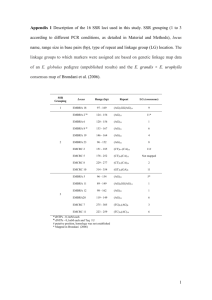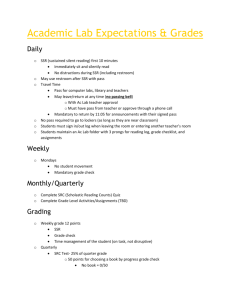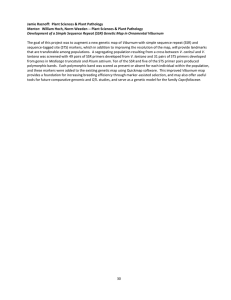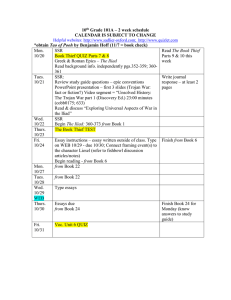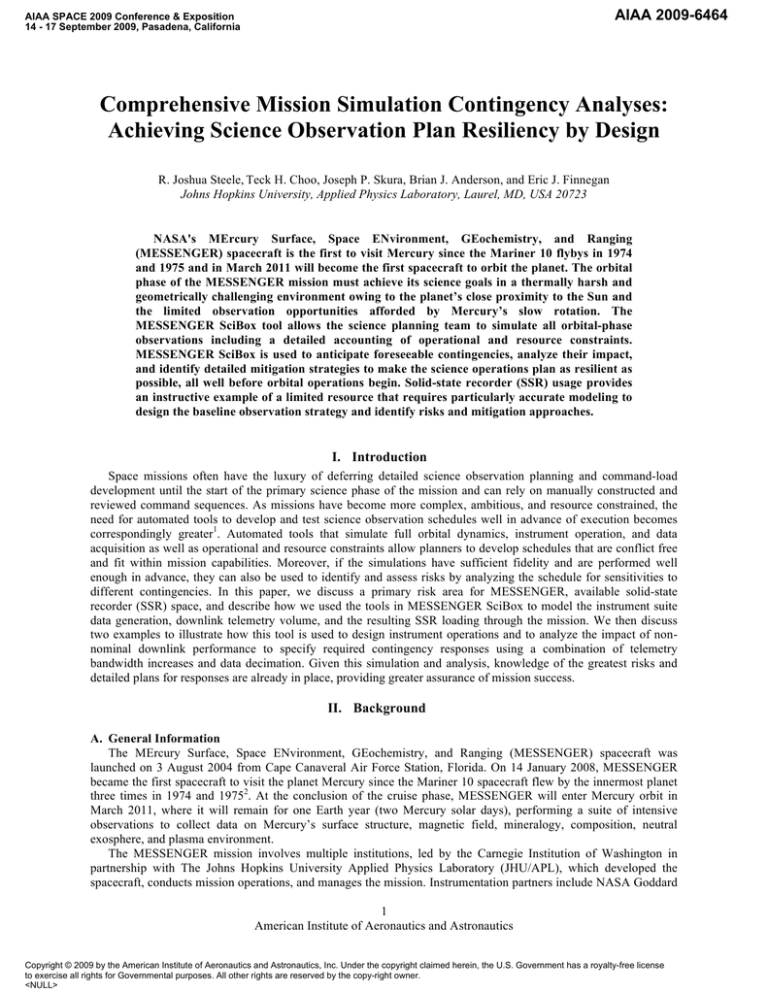
AIAA 2009-6464
AIAA SPACE 2009 Conference & Exposition
14 - 17 September 2009, Pasadena, California
Comprehensive Mission Simulation Contingency Analyses:
Achieving Science Observation Plan Resiliency by Design
R. Joshua Steele, Teck H. Choo, Joseph P. Skura, Brian J. Anderson, and Eric J. Finnegan
Johns Hopkins University, Applied Physics Laboratory, Laurel, MD, USA 20723
NASA's MErcury Surface, Space ENvironment, GEochemistry, and Ranging
(MESSENGER) spacecraft is the first to visit Mercury since the Mariner 10 flybys in 1974
and 1975 and in March 2011 will become the first spacecraft to orbit the planet. The orbital
phase of the MESSENGER mission must achieve its science goals in a thermally harsh and
geometrically challenging environment owing to the planet’s close proximity to the Sun and
the limited observation opportunities afforded by Mercury’s slow rotation. The
MESSENGER SciBox tool allows the science planning team to simulate all orbital-phase
observations including a detailed accounting of operational and resource constraints.
MESSENGER SciBox is used to anticipate foreseeable contingencies, analyze their impact,
and identify detailed mitigation strategies to make the science operations plan as resilient as
possible, all well before orbital operations begin. Solid-state recorder (SSR) usage provides
an instructive example of a limited resource that requires particularly accurate modeling to
design the baseline observation strategy and identify risks and mitigation approaches.
I. Introduction
Space missions often have the luxury of deferring detailed science observation planning and command-load
development until the start of the primary science phase of the mission and can rely on manually constructed and
reviewed command sequences. As missions have become more complex, ambitious, and resource constrained, the
need for automated tools to develop and test science observation schedules well in advance of execution becomes
correspondingly greater1. Automated tools that simulate full orbital dynamics, instrument operation, and data
acquisition as well as operational and resource constraints allow planners to develop schedules that are conflict free
and fit within mission capabilities. Moreover, if the simulations have sufficient fidelity and are performed well
enough in advance, they can also be used to identify and assess risks by analyzing the schedule for sensitivities to
different contingencies. In this paper, we discuss a primary risk area for MESSENGER, available solid-state
recorder (SSR) space, and describe how we used the tools in MESSENGER SciBox to model the instrument suite
data generation, downlink telemetry volume, and the resulting SSR loading through the mission. We then discuss
two examples to illustrate how this tool is used to design instrument operations and to analyze the impact of nonnominal downlink performance to specify required contingency responses using a combination of telemetry
bandwidth increases and data decimation. Given this simulation and analysis, knowledge of the greatest risks and
detailed plans for responses are already in place, providing greater assurance of mission success.
II. Background
A. General Information
The MErcury Surface, Space ENvironment, GEochemistry, and Ranging (MESSENGER) spacecraft was
launched on 3 August 2004 from Cape Canaveral Air Force Station, Florida. On 14 January 2008, MESSENGER
became the first spacecraft to visit the planet Mercury since the Mariner 10 spacecraft flew by the innermost planet
three times in 1974 and 19752. At the conclusion of the cruise phase, MESSENGER will enter Mercury orbit in
March 2011, where it will remain for one Earth year (two Mercury solar days), performing a suite of intensive
observations to collect data on Mercury’s surface structure, magnetic field, mineralogy, composition, neutral
exosphere, and plasma environment.
The MESSENGER mission involves multiple institutions, led by the Carnegie Institution of Washington in
partnership with The Johns Hopkins University Applied Physics Laboratory (JHU/APL), which developed the
spacecraft, conducts mission operations, and manages the mission. Instrumentation partners include NASA Goddard
1
American Institute of Aeronautics and Astronautics
Copyright © 2009 by the American Institute of Aeronautics and Astronautics, Inc. Under the copyright claimed herein, the U.S. Government has a royalty-free license
to exercise all rights for Governmental purposes. All other rights are reserved by the copy-right owner.
<NULL>
Space Flight Center, the University of
Colorado, the University of Michigan, Los
Alamos National Laboratory, and JHU/APL2,3.
B. Instrument Summary
The spacecraft payload is illustrated in
Figure 1 and consists of seven instruments and
the radio science investigation, which uses the
spacecraft's radio frequency (RF) system. The
payload includes a dual imaging system
(MDIS) with wide-angle and narrow-angle
cameras for multi-spectral imaging of
Mercury's surface; gamma-ray (GRS), neutron
(NS), and X-ray (XRS) spectrometers for
remote geochemical mapping; a magnetometer
(MAG) to measure the planetary magnetic
field; a laser altimeter (MLA) to measure
Mercury’s surface topography and planetary
shape; a visible, and near-infrared spectrograph
(VIRS) to obtain high-resolution spectral
measurements of the surface; an ultraviolet and
visible spectrometer (UVVS) to survey the
structure and composition of Mercury’s
tenuous neutral exosphere; and energetic
particle and plasma spectrometers (EPPS) to
characterize the charged particle and plasma
environment of Mercury4.
Figure 1. MESSENGER Science Payload. View shows the
MESSENGER spacecraft main body from the +Z side of the main
body together with detailed views of the payload sub-systems. The
remote sensing instruments are mounted so as to view in the +Z
direction (out of the page). The spacecraft sunshade is on the left in
green, and the solar panels and Magnetometer boom are not shown
in this close-up.
III. Solid State Recorder Description and Load Modeling
MESSENGER science observation planning is a joint effort of mission operations at JHU/APL and the Science
Team and is coordinated by the Payload Operations Manager and the Project Scientist. The planning process3
includes both cruise phase planning and orbital operations. During the orbital mission phase, science planning will
facilitate a three-week turn-around from Science Team command request submission to command execution on the
spacecraft. Operations in orbit at Mercury impose a number of constraints that restrict spacecraft pointing,
observation opportunities, and data volume. Specific constraints include spacecraft pointing restrictions to ensure
thermal safety of the spacecraft, correspondingly limited opportunities to view the planetary surface, variable
available downlink volume due to Earth-Mercury distance variations and solar conjunctions, and consequently
variable load to the onboard SSR1. The SSR loading is a key constraint that is sensitive to the observation plans,
instrument modes, and data playback (downlink) volume. Because of the potential risks to science data and the
spacecraft associated with SSR over-loading, extensive analyses have been done to model data generation and
playback rates and understand the key factors driving SSR usage and approaches that can be used to manage SSR
loading. Although only one of the trade analyses conducted for MESSENGER, albeit one of the most demanding,
the SSR analysis serves as an example of the application of full mission simulation to design and analyze a complete
mission science observation plan to minimize the risks of highly constrained missions.
A. The Solid-State Recorder
The SSR is a synchronous dynamic random access memory (SDRAM) system5 with 8 Gigabits (Gb) total
capacity of which 6 Gb is allocated for science data storage. The remainder of the SSR space is devoted to
spacecraft engineering and contingency data. Data are stored in a series of directories which have assigned downlink
priorities (ranked 0-9). Files within each directory are stored sequentially (first in, first out). The directories of
interest here include two directories for science data files, one for high-priority science data and one for standard
science data where compressed data from the science instruments are stored; one for raw optical navigation images;
and one for raw MDIS camera images. The latter directory is denoted raw space, and images are stored there
temporarily before being compressed and moved to one of the other directories prior to downlink.
2
American Institute of Aeronautics and Astronautics
Because MDIS camera images are the highest-volume data acquired by the instruments, their handling and
compression is crucial to SSR modeling. When an MDIS image is taken, it may be either binned or unbinned.
Binning is done within the MDIS instrument and consists of NxN-pixel averaging, where N is a power of 2 and is
enabled or disabled by instrument command. After binning, the image is losslessly compressed within the MDIS
instrument and then transferred into the raw image directory on the SSR. The maximum transfer time is 4 s for a 12Mb unbinned image6. A raw image remains in this directory until it is compressed by the spacecraft main processor
(MP) using one of a set of lossy compression algorithms selected by command. MP compression times vary
depending on the structure in the image, but are typically five to seven minutes. After MP compression, the image is
stored in the science priority directory identified for each image. To prevent data bus collisions, simultaneous MP
compression and image transfer from MDIS to raw space are not allowed. Because the image capture time is much
shorter than MP compression times, images can back up in raw space during intensive imaging activities. MDIS
could generate 6 Gb of raw image data, corresponding to the entire science data volume on the SSR, in just over 30
minutes. This eventuality would result in an inability to save any new science data until space is freed on the SSR.
Great care must therefore be exercised in scheduling imaging activities, and accurate SSR modeling is an integral
part of the imaging science planning.
The other instruments together can generate more data than can be accommodated, so they must be accurately
modeled as well. Because the rate of data storage to the recorder is determined by settings for all the instruments,
SSR simulation requires specific knowledge of the data rates for each range of settings for every instrument. The
other instruments all use lossless-compression algorithms that execute within each instrument processor before data
are sent to the SSR via the data processing unit (DPU). Estimates for the expected compression factors during orbital
operations have been refined using actual performance metrics obtained from analysis of the Mercury flyby data and
will be monitored and adjusted to ensure that the models closely predict the actual compressed data volumes.
Certain science observations are made in response to events sensed by an instrument. For example, the MAG and
XRS instruments have burst modes that generate specific data packets when triggers sensed within these instruments
are set. For XRS the trigger is the occurrence of a solar flare sensed in real-time by the solar monitor sensors of
XRS. For MAG the trigger is enhanced 110-Hz band-pass fluctuations in the onboard digitally filtered magnetic
field data. These burst data introduce uncertainties in the data volume estimate in addition to uncertainties in the
actual compression factors achieved.
The order in which data are downlinked is determined both by the directory priority and by the file architecture.
Data files on the SSR have particular downlink priority and file attributes. Instrument data sent via the DPU are
structured in packets, and each packet is labeled with an application identifier (APID). The SSR file to which each
packet is written is assigned on the basis of the APID label, and each APID can be directed to at most two files,
although typically each APID is directed to just one file. Multiple APIDs can, however, be directed to the same SSR
file. For example, high-priority science data packets from all instruments except MDIS are stored in the same SSR
file. The SSR model therefore also includes the mapping between APIDs and SSR files as well as the SSR directory
structure.
C. Data Downlink
As the Earth-Mercury distance and Mercury-Sun-Earth angle change through the mission, the downlink rate
varies considerably. This is a primary driver in SSR loading. The downlink rate drops to zero at both superior and
inferior conjunction when the Sun, Mercury, and Earth are nearly aligned. It is difficult to predict the extent or depth
of these conjunction minima in downlink in part because the phase distortions depend on the structure of the
plasmas in the solar corona which are unpredictable. The Deep Space Network (DSN) performance also varies with
DSN availability (e.g., antenna outages, performance impacts, launch support, other spacecraft emergency
declarations) and DSN ground station and dish assignment. The payload observation schedule for the remote sensing
instruments is primarily driven by the spacecraft orbit and resulting viewing and illumination conditions at Mercury.
At times the demands for data acquisition, storage, and downlink are at odds with the downlink performance.
Accurate data throughput modeling is therefore required to support observation planning to conserve SSR volume at
times of low downlink rates. Moreover, the uncertainties in predictions reinforce the need for high-fidelity models of
SSR loading to support short-term tracking of returned data, near-term prediction of available SSR space, and
regression testing to identify the sensitivity of SSR loading to contingencies.
D. Avoiding Solid-State Recorder Overflow
Knowledge of both data storage rates and downlink capabilities are required to ensure that the available SSR
space allocated to science data is never exceeded. The influence on SSR usage of observational parameters (e.g.,
image settings, instrument data rates, instrument compression values) and data playback from the recorder (e.g.,
3
American Institute of Aeronautics and Astronautics
bandwidth rates and downlink windows) must be understood to design an observation plan that both avoids SSR
overflow under nominal performance and allows analysis to design contingency responses. Parameterized analysis
of the SSR loading dependence on instrument settings and downlink performance is vital in order to design effective
mitigation plans in the event of non-nominal downlink performance (e.g., degradation in radiated antenna power)
and to understand how to adjust the observation plan if data volumes deviate from predictions.
IV. Approach
The operational challenges described above imply two key characteristics about science observation planning: it
must be performed well before Mercury orbit is reached; and it must be tolerant to the inevitable unexpected events
that will occur. These characteristics require a high-fidelity model of the systems involved and the ability to adjust
parameters to identify key sensitivities and investigate potential problem areas. The MESSENGER SciBox planning
tool1 provides the Science Team the ability to perform advanced science planning, investigate a variety of scenarios
to identify and quantify risks, and generate and analyze detailed reports on instrument activity, coverage, and data
storage and throughput.
A. SciBox as a Planning Tool
The science planning process3 uses MESSENGER SciBox as its primary planning tool. Concepts of operation of
all the instruments have been encoded into software algorithms, along with spacecraft performance characteristics,
physical constraints, instrument observation requirements, and mission science requirements. The tool also
incorporates instrument and spacecraft subsystem models, including the data types and volumes generated by each
instrument and their corresponding file structures on the SSR. MESSENGER SciBox can generate science payload
operation schedules1 for the entire orbital mission, enabling designers to assess whether the schedules achieve the
mission science observations requirements while ensuring that execution remains within the various constraints of
the instruments and spacecraft at all times, including spacecraft pointing, spacecraft power, mission operations
activities, SSR capacity, and downlink volume. The remainder of the paper discusses the modeling and analyses for
the last two of these constraints.
B. The Solid-State Recorder Model
MESSENGER SciBox contains a high-fidelity model of the SSR. From design documentation, spacecraft
operating procedures, and consultation with mission operations and spacecraft design engineers, software models
were implemented to represent the state of the recorder. The previously discussed directory structure and the
mapping of instrument data to SSR files on each directory are modeled to track the files waiting to be downlinked
and to record when they are downlinked and deleted from the SSR. The SSR directory priority is defined by an
onboard table that sends data tied to particular APIDs to particular priority files on the recorder. Open files to which
instruments are currently writing data are also represented. The histories of open files are maintained both globally
and by APID, since more than one APID can write to a file. Once the files are closed prior to downlink, they are
recorded as stored in their designated directories to await downlink.
C. Data Downlink
Downlink via the DSN is also modeled. Bandwidth availability predictions generated by the engineering team
provide a baseline for the drain rate from the recorder. Within a DSN pass, sufficient time is set aside for track setup
and tear-down procedures between the spacecraft and DSN. Knowledge of the downlink windows and available data
rates allow prediction of when files are downlinked and removed from the recorder. The higher-priority data files
are downlinked before lower-priority data such as contingency data (directory 9) that are downlinked only if all
other directories are cleared (or in the event of an anomaly investigation). The downlink schedule used by
MESSENGER SciBox can be modified during the near-term science planning phase3 to respond to changes in the
actual downlink track attributes, principally the bandwidth actually achieved, which varies with the size of the dish
used, the DSN station chosen, and conditions locally at the DSN site and in space.
D. Software Model
MESSENGER SciBox uses a two-pass model to derive the overall SSR profile. First, the instrument schedules
are processed to determine the overall SSR load over the entire mission. Internal representations of the instrument
states are maintained, and when instrument commands are applied to those states, the time profiles of instrument
data rates sent into the solid-state recorder are determined. Each instrument maintains a mapping between its data
4
American Institute of Aeronautics and Astronautics
packets and its APIDs, which in turn map to specific files. Those instrument schedules, data to APID mappings, and
APID to SSR file mappings are combined to determine the overall load on the recorder over the entire mission.
In the second modeling pass, the downlink process runs over the data on the recorder. First, files are created
prior to each downlink track from the currently open files (thus modeling the mission operations process performed
for each DSN pass), and those closed files are identified as “placed” in the appropriate downlink directories. For
each downlink window in the downlink schedule, a list of files awaiting downlink is generated, taking into account
the downlink priority scheme, and the list of files downlinked on each pass is constructed and those data logged as
transmitted to Earth. All pertinent information is modeled and stored for analysis with each run. This simulation
information includes the file SSR save-time; file sizes including raw images, MP compressed images, and
compressed data from all non-imaging instruments; file histories; and downlink times.
E. Orbit Phase Planning Processes
Science planning during the mission’s orbital phase is divided into two processes that run concurrently, Advance
Science Planning (ASP) and Near-Term Science Planning (NTSP)3. The ASP cycle delivers a new baseline
observation plan every five weeks and captures changes to instrument concepts of operations and spacecraft
pointing. The revised baseline plans are reviewed against the mission observation objectives prior to
implementation. The NTSP process operates on a three-week cycle and consists of converting the baseline
observation plan into commands that are submitted to mission operations for testing and incorporation in the
command load that executes on the spacecraft. Changes to instrument modes that do not affect spacecraft pointing
are permitted in the NTSP cycle. Since spacecraft pointing scheduled by the instrument that “owns” attitude is used
by other instruments to plan their observations, changes to spacecraft pointing are not permitted in the NTSP cycle.
F. SSR Analysis Tools
1. Observation Schedule Variations
MESSENGER SciBox allows the user to manipulate the instrument schedules (within the limits of the planning
process3), either manually via the individual instrument schedule editors (primarily for use in the NTSP cycle), or
through the adjustment of opportunity selection parameters (primarily for use in the ASP cycle)1, and quickly rerun
the reporting tools to generate a new set of reports. This procedure allows side-by-side comparison between different
runs to determine the net impact of the proposed changes.
2. SSR Analysis Tool
Once a series of schedules has been created, the commands generated by those schedules can be simulated and
modeled within MESSENGER SciBox. The SSR analysis is then performed, simulating the data flow both into and
out of the recorder. This modeling results in a mission-wide profile for the loading of the recorder (see section D
above). In the case of predicted overflow, MESSENGER SciBox allows a user (e.g., an MDIS instrument team
member) to adjust parameters in the observation schedule, save these changes, and reanalyze the revised schedule
for affects to the instrument measurement coverage and SSR loading.
Data volume for each directory on the solid-state recorder can be viewed, taking into account all instrument
activities that place information into that directory, the available downlink, as well as the priority scheme for placing
information on the recorder. This view allows the spacecraft engineering team to ensure that no SSR volume or file
count limits have been surpassed. Several summary time-series plots are also produced, including displays of the
entire SSR volume (all directories), the raw image directory volume, and the net volume of all other directories
combined excluding the raw image directory. These displays provide diagnostics of the nature and timing of SSR
overload intervals.
The time histories of individual instrument data volume is also evaluated and displayed. The instrument SSR
histories account for instrument activities, corresponding data generation rates, the available downlink, SSR data
residence times, and SSR storage used and downlink priority. This view allows instrument teams to ensure proper
implementation of their overall concept of operations and data campaigns, if any, and ensure that their instruments
do not exceed their daily data volume allocation.
3. Contingency Analysis Tool
In addition to generating plots, reports, and detailed information on specific observation schedules, tools within
MESSENGER SciBox also allow users to adjust a range of attributes of the SSR model (e.g., compression times,
compression factors, ability to downlink images directly from the raw image directory) or the individual instrument
schedule and quickly re-simulate the SSR loading profile over the entire mission duration or other period of time.
5
American Institute of Aeronautics and Astronautics
One of these tools is the Contingency Analysis Tool. This tool examines impacts associated with the downlink
system and how best to employ mitigation techniques. Events affecting performance can be placed at any time
during the mission and last for any specified amount of time. The tool also includes a capability to perform repeated
simulations by moving a sliding window of an event occurrence through the mission, allowing an analyst to identify
key weak points in the downlink schedule, e.g., to identify when the loss of downlink bandwidth would be most
critical. This tool enables analysis of situations to identify worst-case scenarios and recovery options to ensure that
mission performance impacts are fully understood and characterized and mitigation steps identified (see section V
below).
Adverse events presently implemented in the contingency analysis tool include the loss of one downlink pass,
the loss of two or more consecutive downlink passes, and the loss of one of the spacecraft solid-state power
amplifiers (SSPAs) that provide RF antenna power. Available mitigation techniques implemented in the tool include
increasing the available downlink bandwidth by a user-specified factor, employing a 70-m-diameter DSN antenna in
lieu of a 34-m DSN antenna, and arraying two DSN 34-m antennas together for a downlink pass. The detailed
modeling of instrument data volumes allows assessment of data decimation by changing instrument states as well.
V. Examples
There are many factors that affect SSR loading, but the two dominant effects are the MDIS imaging schedule
and compression and the RF antenna performance. The SSR simulation and analysis for a range of MDIS
compression approaches is discussed below, and a solution that resolves potential SSR overflows is presented. A
number of similar analyses for other instruments and variations of observation timelines have been made. This
example illustrates how the SSR modeling was used to guide the development of the science observation schedules.
Perhaps the performance degradation with the greatest negative impact on data throughput would be the loss of
an SSPA. There are two SSPAs onboard the spacecraft, and either one can power the high-gain antennas, but
normally both SSPAs are used to maximize radiated power. The loss of one SSPA onboard the spacecraft would cut
the available downlink bandwidth to 25% of its full-power rate. Depending on when the SSPA is lost, it may be
impossible to accommodate all of the baseline science observations with the nominal DSN downlink profile. In that
event, options to accommodate the new bandwidth restriction include applying greater compression to the science
data, reducing instrument sampling rates, removing selected non-essential observations from the baseline
observation schedule, and adding additional DSN capability to partially offset the loss of spacecraft radiated RF
power.
A. Defining Imaging Compression Strategy
Image data from MESSENGER's MDIS camera dominate the SSR throughput. As described above, images are
temporarily stored in a raw instrument format until they can be compressed further by the spacecraft MP using lossy
compression algorithms. Because image acquisition in raw form is much faster than MP compression, backup of raw
images on the SSR waiting for MP compression can occur, resulting in inefficient use of SSR space. Designing an
imaging plan that minimizes raw space backup was identified as a key objective for SSR management. The most
memory-intensive MDIS observations are color observations. Each color observation consists of eight images taken
in series, each using a different spectral filter. In the original operations concept these images were collected using
the full 12-bit dynamic range of the instrument and compressed using wavelet MP compression with a compression
ratio of 8:1.
The priority of imaging observations governs the order in which different MDIS observations are planned and
therefore impacts SSR loading. In order of importance the imaging objectives are (1) monochrome mapping, (2)
color mapping, and (3) stereoscopic imaging. Because the year-long orbit phase consists of only two Mercury solar
days, the highest two priorities were scheduled for solar day 1 so that any observations that might be missed could
be rescheduled for the second solar day by sacrificing some of the lower-priority stereoscopic imaging. The most
memory-intensive MDIS observations therefore occur in the first solar day.
6
American Institute of Aeronautics and Astronautics
The overall SSR profile for the entire
mission and all instruments for the original
MDIS color mapping operations concept is
shown in the top panel of Figure 2. The red
horizontal line denotes the 6-Gb limit for
science data, and the red and blue traces
show the data volume and file count,
respectively. The 6-Gb limit is exceeded
several times during the first Mercury solar
day (the left half of the plot). These peaks
correspond to periods of intense color
imaging, and the primary contributor is the
raw space directory, indicating that the
problem is caused by backup in raw space.
To solve this problem the color images
need to be smaller and, if possible, the
compression time reduced.
The SSR profile for a revised color
mapping operations concept in which the
color images were collected with 8-bit
dynamic range but with a compression
ratio of 4:1 is shown in the bottom panel of
Figure 2. The raw images are 2/3 as large
in this scenario, resulting in smaller images
in the raw image directory, and because Figure 2. SSR loading profile for two image compression
they are smaller to begin with and are schemes. The top panel shows the SSR profile obtained using 12-bitcompressed less they compress faster. Note resolution MDIS color imaging and 8:1 wavelet image compression,
in particular that the initial sharp peak is and the bottom panel shows the profile using 8-bit color resolution
nearly eliminated and the timing of the and 4:1 wavelet compression. The red trace shows the total SSR
highest peaks in the first solar day has science data volume (right-hand scale), and the blue trace shows the
changed, reflecting that the SSR loading is number of science data files (left-hand scale). The horizontal red line
now governed by downlink rather than by is the 6-Gb maximum science volume allocation on the SSR.
color images backing up in raw space. Thus despite the fact that the compressed color images are larger, the SSR
load is actually reduced, and the science volume remains below the 6-Gb limit at all times.
B. Loss of a Solid-State Power Amplifier
The baseline observation schedule is based on the assumption that both SSPAs are fully functional through the
duration of the mission. The impact of losing an SSPA therefore depends critically on when it occurs. If the failure
occurs after the majority of the imaging has taken place, it may be possible to accommodate the downlink of the
remaining schedule with the lower bandwidth. However, if the loss occurs early, significant changes to the science
observing plan may have to be made, both to obtain what is currently on the SSR and to ensure that future data
accumulation does not overflow the recorder. As seen in Figure 2, there are critical times in the mission when the
SSR loading peaks and inability to drain data off the SSR would be most inopportune and could severely impact the
science observing plan.
MESSENGER SciBox has the ability to manipulate the available downlink schedule to include time windows
and bandwidth variations, e.g., to emulate use of single or dual DSN 34-m antennas or a 70-m antenna. The
contingency analysis tool (section III.F above) can be used to quickly rerun a given baseline instrument schedule
with a variety of downlink schedules, allowing an analysis of the impact of an SSPA loss. By running a suite of
simulations as a function of the day that the simulated SSPA loss occurs, the contingency analysis tool can be used
to show the effect in recorder volume and help pinpoint where in the mission such a loss would be most critical.
A series of SSR loading profiles, each displaying the SSR load for the loss of an SSPA at a different time during
the mission, is shown in Figure 3. Each panel uses the same format as Figure 2, with the addition in most panels of a
horizontal blue line that shows the overall SSR file count limit. Simulations were run stepping the SSPA
contingency by 9-day intervals, but each panel in Figure 3 shows results for every fourth run. The first plot shows
the effect of losing an SSPA at the start of the mission (with the current baseline schedule), and each subsequent
profile delays the SSPA failure by an additional 36 days relative to the previous panel. The plot clearly shows that
7
American Institute of Aeronautics and Astronautics
Figure 3. SSR usage profiles for non-nominal SSPA
performance. Plots show the SSR profile that would result
if an SSPA failed at the time indicated in each panel. The
formats are the same as Figure 2. Any loading in excess of
6 Gb (red horizontal line) exceeds the allowed range.
Figure 4. Downlink and SSR performance
for SSPA contingency analysis. Plot of daily
downlink
volume
for nominal SSPA
performance (top panel, thin trace),
compromised
average
daily
downlink
performance (top panel, thick trace), daily
excess data generated averaged over 9-day
intervals (middle panel), and ratio between
compromised downlink capability and daily
excess data generated.
the loss of an SSPA early in the mission would overflow the solid-state recorder rather quickly, on approximately
day 30. Losing the SSPA on day 144 results in SSR overflow shortly after the first solar day. After day 315, the loss
of an SSPA reduces the recorder margin, but the remaining observing schedule does not overflow the SSR.
These simulation results are used to identify mitigation steps in response to this SSPA contingency. We
evaluated the additional downlink capability or data compression/decimation required to stay within the downlink
and SSR capabilities as functions of the day during the mission when the SSPA contingency occurs. This analysis is
summarized in Figure 4. The nominal daily downlink volume, 9-day averaged downlink volume with one SSPA, 9day averaged daily excess data volume added to the recorder after SSPA loss, and ratio between the excess data
volume and single-SSPA daily downlink volume are all plotted versus days after MOI. The ratio between the singleSSPA downlink rate and the amount of data added per day that would exceed SSR capacity corresponds to the
relative downlink deficit.
To make up the downlink deficit one must either decrease the relative data volume or increase the downlink. For
much of the mission the downlink deficit is below a factor of 4. Because 70-m DSN antennas provide a factor of 4
higher downlink than the 34-m antennas baselined in the nominal mission plan, one could in principle mitigate much
of the SSPA loss by using 70-m DSN support. Alternatively, though less desirably, doubling the binning used for
imaging provides a factor of 4 data volume savings and could also be used. Reductions in other instrument data
volumes can also be made to reduce the image resolution degradation required. Some combination of these options
must be used when the downlink deficit exceeds 4. There are two intervals for which the downlink deficit exceeds
16, and these both correspond to superior conjunction times. One would therefore need to apply a combination of
data decimation and downlink increases before and after these severely limited downlink intervals. This example
illustrates the usefulness of full mission simulations to develop mitigation strategies and contingency responses well
in advance so that relevant resource and science trades can be made deliberatively.
8
American Institute of Aeronautics and Astronautics
VI. Summary
MESSENGER's observation campaign in orbit around Mercury presents many challenges to science observation
planning: a slowly rotating target body that presents limited opportunities for viewing any given region on the
planet; a highly elliptical, non-Sun-synchronous orbit geometry; restrictive spacecraft pointing constraints to
maintain a safe thermal environment for spacecraft and payload subsystems; an array of instruments with different
measurement requirements, some of which are in competition for constrained resources; and resource constraints on
downlink bandwidth and solid-state recorder space. Mission science planning therefore requires precise and
carefully orchestrated instrument operation schedules and a planning process that can anticipate contingencies and
respond rapidly to foreseen and unforeseen operational events. MESSENGER SciBox provides a unique set of tools,
allowing a thorough analysis of the vital mission parameters, resulting in a complete schedule that obeys all of the
mission and spacecraft operational constraints and is completed well before orbital operations commence. The tool
also provides a suite of reports and visualization interfaces that allow instrument scientists to review and revise their
schedules to ensure that instrument measurement requirements and mission science requirements can be achieved.
Furthermore, MESSENGER SciBox has been used to perform contingency analysis by adjusting spacecraft, ground
station, and instrument parameters to address a variety of ''What if?'' scenarios, allowing development of mitigation
strategies in advance of orbital operations. The MESSENGER SciBox tool is an integral part of operations planning
to ensure that the schedule developed for the mission is not only successful in achieving the science, but is resilient
to the range of challenges that may be encountered while on orbit.
Acknowledgments
The MESSENGER mission is supported by the NASA Discovery Program under contracts NASW-00002 to the
Carnegie Institution of Washington and NAS5-97271 to The Johns Hopkins University Applied Physics Laboratory.
We thank Sean C. Solomon, Principal Investigator, and Peter Bedini, Program Manager for their support in the
preparation of this paper. We also thank everyone on MESSENGER mission operations and engineering teams for
working with the MESSENGER SciBox team to support the quantitatively accurate modeling of spacecraft systems
and operations.
References
1
Choo, T. H., Anderson, B. J., Bedini, P. D., Finnegan, E. J., Skura, J. P., and Steele, R. J., “The MESSENGER Science
Planning and Commanding System”, AIAA Space 2009 Conference and Exposition, 11 pp., Pasadena, Calif., Sept. 14-17, 2009
(to be published)
2
Solomon, S. C., McNutt, R. L., Jr., Gold, R. E., and Domingue, D. L., “MESSENGER Mission Overview”, Space Science
Reviews, Vol. 131, Issues 1-4, pp. 3-39, 2007.
3
Berman, A. F., Domingue, D. L., Holdridge, M. E., Choo, T. H., Steele, R. J., and Shelton, R. G., “Orbital Operations
Planning and Scheduling for the MESSENGER Mission”, 6th International Workshop on Planning and Scheduling for Space, 10
pp., Pasadena, Calif., July 19-21, 2009.
4
Gold, R. E., McNutt, R. L., Jr., Solomon, S. C., and the MESSENGER Team, “The MESSENGER Science Payload”,
Proceedings of the 5th International Academy of Astronautics International Conference on Low-Cost Planetary Missions, Special
Publication SP-542, edited by R. A. Harris, European Space Agency, Noordwijk, The Netherlands, pp. 399-405, 2003.
5
Leary, J. C., Conde, R. F., Dakermanji, G., Engelbrecht, C. S., Ercol, C. J., Fielhauer, K. B., Grant, D. G., Hartka, T. J.,
Hill, T. A., Jaskulek, S. E., Mirantes, M. A., Mosher, L. E., Paul, M. V., Persons, D. F., Rodberg, E. H., Srinivasan, D. K.,
Vaughan, R. M., and Wiley, S. R., “The MESSENGER Spacecraft”, Space Science Reviews, Vol. 131, Issues 1-4, pp. 187-217,
2007.
6
Hawkins, S. E., Boldt, J. D., Darlington, E. H., Espiritu, R., Gold, R. E., Gotwols, B., Grey, M. P., Hash, C. D., Hayes, J. R.,
Jaskulek, S. E., Kardian, C. J., Keller, M. R., Malaret, E. R., Murchie, S. L., Murphy, P. K., Peacock, K., Prockter, L. M., Reiter,
R. A., Robinson, M. S., Schaefer, E. D., Shelton, R. G., Sterner, R. E., Taylor, H. W., Watters, T. R., and Williams, B. D., “The
Mercury Dual Imaging System on the MESSENGER Spacecraft”, Space Science Reviews, Vol. 131, Issues 1-4, pp. 247-338,
2007.
9
American Institute of Aeronautics and Astronautics


